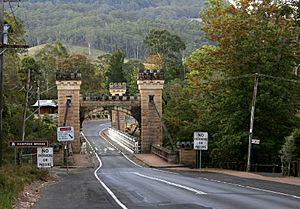Hampden Bridge, Kangaroo Valley facts for kids
Quick facts for kids Hampden Bridge |
|
|---|---|

Hampden Bridge, pictured in 2008
|
|
| Coordinates | 34°43′40″S 150°31′16″E / 34.72778°S 150.52111°E |
| Carries | Moss Vale Road |
| Crosses | Kangaroo River |
| Locale | Kangaroo Valley, City of Shoalhaven, New South Wales, Australia |
| Other name(s) | RTA Bridge No.875 |
| Named for | Henry Robert Brand, 2nd Viscount Hampden |
| Owner | Roads and Maritime Services |
| Characteristics | |
| Design | Suspension bridge |
| Material | Steel cables |
| Trough construction | Timber deck |
| Pier construction | Crenellated sandstone turrets |
| Total length | 77 metres (252 ft) |
| Width | 5 metres (18 ft) |
| Number of spans | 1 |
| History | |
| Architect | Ernest de Burgh |
| Constructed by | Loveridge and Hudson |
| Construction begin | 1895 |
| Construction cost | A£8,000 |
| Opened | 19 May 1898 |
| Inaugurated | by James Henry Young |
| Replaces | 2-span timber truss bridge, 1879 |
| Official name: Hampden Bridge | |
| Type: | State heritage (built) |
| Designated: | 2 August 2019 |
| Reference #: | 2024 |
| Type: | Road Bridge |
| Category: | Transport - Land |
| Builders: | Loveridge and Hudson |
The Hampden Bridge is a special suspension bridge in Kangaroo Valley, Australia. It carries Moss Vale Road (B73) over the Kangaroo River. This bridge is very old and important, so it's protected as a heritage site.
The bridge was designed by Ernest de Burgh and built by Loveridge and Hudson. It opened on May 19, 1898. It was named after Lord Hampden, who was the Governor of New South Wales from 1895 to 1899.
Contents
Discovering Hampden Bridge's Past

Hampden Bridge was built to replace an older wooden bridge that was falling apart. Ernest Macartney de Burgh, an engineer for bridges, designed it. Construction started in 1895 and was done by Thomas Loveridge and Herbert Hudson.
The new bridge opened on May 19, 1898. Just six days later, big floods washed the old bridge away! This shows how important it was to have the new, stronger bridge ready. The opening day was a public holiday in Kangaroo Valley.
How Kangaroo Valley Grew Over Time
The land around Kangaroo Valley has a long history. It was originally the country of the Dharawal people. They used the valley as a safe place for animals and a meeting spot. They had special names for places, like "Noggarah" for a big gully and "Parronrah" for good camping areas.
European settlers, like cedar cutters and cattlemen, arrived in the 1800s. This changed the way of life for the Aboriginal people. Many were later moved from their lands. However, their history remains in places like old campsites and rock art.
European settlement began around 1810. Farmers started bringing cattle to the valley. By the 1840s, Charles Throsby had explored routes through the valley. This helped connect the coast to other settled areas.
Dairy farming became very popular in the valley. By the 1880s, the population grew a lot as dairy farmers moved in. Kangaroo Valley became a major producer of butter. But getting goods out of the valley was hard because they had to cross the Kangaroo River.
Early Bridges in Kangaroo Valley
To help with travel, a two-span wooden bridge was built over the Kangaroo River in 1879. It was called the Kangaroo Valley Bridge. This bridge made it much easier for people and businesses in the valley. It helped the butter factories and the main town grow.
However, this wooden bridge started to wear out quickly. By 1893, it needed extra support. People then decided to build a new, stronger bridge. This new bridge would become the famous Hampden Bridge.
Today, Kangaroo Valley is a popular place for tourists. The Hampden Bridge is a major landmark and still the main way to cross the Kangaroo River.
Early Bridges in New South Wales
The very first bridge in New South Wales was a simple wooden one built in Sydney in 1788. It was washed away by floods soon after. The first "permanent" bridge was made of stone in 1803, but it also collapsed after only three years!
For a long time, NSW didn't have many experts in bridge building. This changed when David Lennox, a skilled bridge engineer, arrived in 1832. He became the Superintendent of Bridges for NSW.
In the early days, most bridges were made of stone or timber. Stone was popular because convict labor kept costs low. But when convict transportation stopped, timber became a cheaper option. Australian hardwoods were strong and plentiful, allowing for large timber bridges.
Suspension Bridges in New South Wales
Suspension bridges are not very common in New South Wales. They are often used for walking paths over rivers.
The first suspension road bridge in NSW was built in 1892 at Long Gully, Northbridge in Sydney. It had a wooden deck, steel cables, and fancy sandstone towers. But over time, the steel parts rusted. So, in 1939, it was replaced with a concrete arch bridge, though the original sandstone towers were kept.
Hampden Bridge was the second suspension bridge built for roads in NSW. It is now the only surviving suspension road bridge from the 1800s in the state! It replaced the older timber bridge and was designed by Ernest Macartney De Burgh.
Building the Hampden Bridge
Designing and Constructing the Bridge
Ernest de Burgh started designing the new suspension bridge in 1895. He planned for stone towers, steel cables, and a timber deck. The stone for the towers was taken from a quarry right near the bridge site.
The company Loveridge & Hudson built the bridge. They were known for their work on other important buildings in Sydney.
Building the bridge had its challenges. For example, the first set of wire cables wasn't good enough, so new ones had to be ordered from London. It took a while, but by July 1897, the cables were finally installed.
The bridge was ready for traffic in February 1898. Just before its official opening, a huge flood hit the area. The old timber bridge was washed away, but the new Hampden Bridge, built two meters higher, survived!
The official opening was on May 19, 1898. The Minister for Works, James Henry Young, opened it in front of 400 people. He said it was an amazing engineering feat. The bridge cost about A£8,382 to build. In 1987, it was named one of the fifty most historic bridges in NSW.
What Makes Hampden Bridge Special?
Hampden Bridge is a famous landmark in Kangaroo Valley. It's about 120 kilometers southwest of Sydney. The bridge stands out with its four large, fancy towers made of local sandstone. These towers look like old castles, with crenellated (notched) tops. This grand design shows how important this river crossing was when it was built.
The bridge has one lane for cars and two narrow paths for people walking. It can hold trucks up to 42.5 tonnes, but only one truck can be on the bridge at a time.
Hampden Bridge is unique because it's the only suspension bridge from the 1800s still used by cars in New South Wales. It's also the oldest timber suspension bridge still carrying vehicles in all of Australia!
In 2012, the bridge had a big renovation that cost A$3 million. This helped keep this important structure in good shape.
Bridge Towers and Supports
The bridge's towers are built from sandstone found nearby. They have a Victorian Gothic style, similar to old castles. Each tower has two main sections connected by an archway where cars drive through.
These towers are about 12.8 meters (42 feet) high. They sit on strong concrete blocks. The top parts of the towers have battlements, like a castle, making them look very grand.
Underneath the towers, strong steel cables are anchored deep into the sandstone bedrock. These anchors are very important because they hold the entire bridge in place. There are even drainage tunnels to keep water away from these anchor pits.
Suspension Cables and Hangers
The main cables of the bridge are made of fourteen strong steel wire ropes. Each rope is 36mm thick. These ropes are grouped into two main cables, with seven ropes in each. They are anchored vertically into pits at both ends of the bridge.
From these main cables, thinner steel rods called "hangers" hang down. These hangers are spaced out every 1.8 meters (6 feet) and support the bridge deck.
The Bridge Deck
The bridge deck is the part you drive or walk on. It's made of timber beams and planks. To make the bridge stronger and prevent too much movement, it has stiffening trusses along each side. These trusses are like a strong framework that helps spread the weight of vehicles.
The bridge also has lights to show off its towers at night. There are also safety features like grilles to stop birds from nesting in certain areas and security grilles for the anchor tunnels.
Bridge Condition and Changes
The Hampden Bridge is in good condition today because it gets regular maintenance. It still looks very much like it did when it was first built.
Over the years, the bridge has had some updates:
- It has been regularly maintained since 1898.
- Major re-decking (replacing the timber deck) happened between 1938 and 1942.
- In the 1960s, limits were put on how heavy vehicles could be (20 tonnes) and how fast they could go (15 mph or 24 km/h).
- In 2003, the load limit was increased to 42.5 tonnes.
- In 2008/2009, some timber decking was replaced again.
- Major works were also done in 2011.
Why Hampden Bridge is a Heritage Site
Hampden Bridge is very important to the history of New South Wales. It's special for several reasons:
- A Link to the Past: For over 110 years, it has been a vital route for farming in Kangaroo Valley and for travel between Sydney and the south coast. It helped the dairy industry grow in the early 1900s. The bridge's grand design shows how important this crossing was. It also stands on land that was a significant meeting place for the local Aboriginal people.
- Connected to Important People: The bridge is linked to Ernest Macartney de Burgh, a famous engineer in NSW. He designed many important structures, including dams for Sydney's water supply. The builders, Loveridge and Hudson, were also well-known for their stonework.
- A Beautiful and Clever Design: The bridge is very attractive with its castle-like sandstone towers. It acts like a gateway to Kangaroo Valley. Building it was a big and difficult engineering challenge for its time. Even today, you can see the clever design and how the bridge moves slightly when heavy traffic crosses it.
- One of a Kind: Hampden Bridge is rare! It's the only timber-decked suspension bridge from the 1800s that still carries cars in NSW. It's one of the few suspension bridges ever built for roads in the state. This makes it a unique example of early bridge design and technology.

